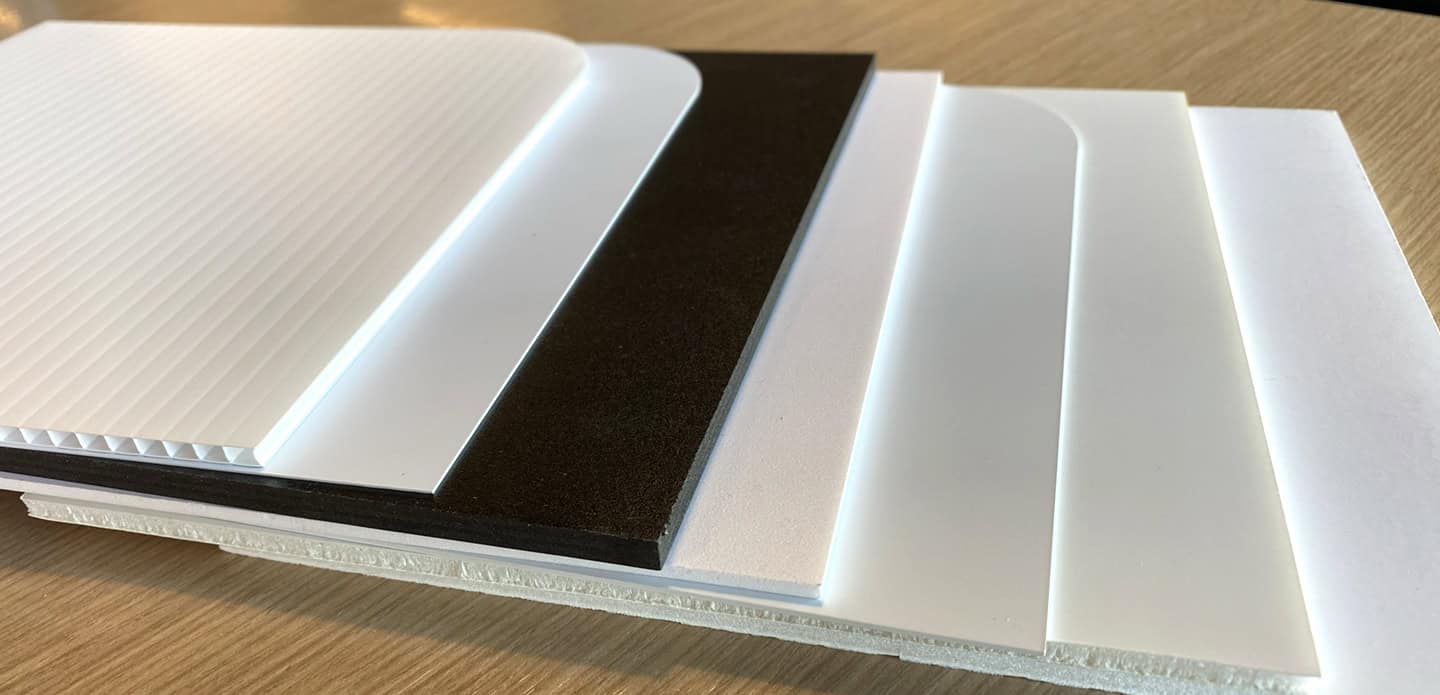The Ins and Outs of Signage Substrates

Demystifying large format substrates and how to choose the best options for your brand.
Sintra, who? Corrugated, what? Polycarbonate… wait, is that a soda?
With all the strange jargon and obscure brand names, selecting substrates for your brand’s signage can feel more like a nightmarish chemistry class than a meeting with your printer! But not to worry, we’re here to fill you in on everything you need to know to avoid sub-par substrate selection and ensure your signage is suitable for its intended application. Let’s begin by demystifying the three main identifiers printers use to categorize large format substrates.
How substrates are classified
First things first, assess the desired athleticism of your signage – that is, how flexible should it be? Rigid signage is typically stored in flat sheets, has some dimension to it, and may be installed as a standalone piece or within a frame. If you’re looking for unique shapes or cutouts, this is likely what you’ll want. Rolled substrates are aptly named as they are not only stored IN ROLLS but also can be printed and re-rolled for easy transport and installation. Think banners, wallpaper, etc.
Once you know your base material type, consider the location and desired level of permanence. Some substrates are classified as weatherproof, meaning they hold up to extreme heat and cold without warping, melting, rusting or fading. Special finishes and laminates can also be applied to materials that are not innately weatherproof to make them so. These are great for exterior and long-term signage needs, as they are more durable. Predictably, this can also make them a more expensive option. However, there are plenty of signage applications, particularly in the retail world, that don’t require such high levels of permanence.
Know your options: common signage substrates
Next, let’s get into options. We’ve outlined some of the most common signage substrates below, but keep in mind that this is by no means an exhaustive list.
RIGID MATERIALS:
ALUMINUM
Aluminum is often desired for its stand-out aesthetic qualities. In other words… it’s super shiny! It’s highly durable yet lightweight, making it ideal for long-term installations, and it can be used for a variety of applications both indoors and outdoors including signage requiring photo-quality graphics.
STYRENE
A semi-rigid plastic material ideal for indoor displays, it’s impact resistance makes it ideal for signage used in point of purchase (POP) displays and interior window graphics as it doesn’t dent or scuff easily with frequent handling.
CORRUGATED PLASTIC
Often referred to as coroplast, this substrate has a construction similar to cardboard, only made of plastic – making it better suited for outdoor use. It is lightweight and commonly used for short term exterior signage like promotional lawn and real estate signage.
EXPANDED PVC
The brand name you might often hear buzzing around this category is Sintra®, and it’s a favorite of ours too. This premium option for long-term indoor use is available in a range of colors and thicknesses. Common applications include posters, in-store displays, and cut outs.
FOAM BOARD
These rigid, indoor substrates all have a similar construction consisting of foam on the interior and various materials on the exterior. Foamcore for example, has a paper exterior making it more affordable, and better for short term signage. Ultraboard on the other hand, has a harder plastic exterior making it an excellent choice for vividly printed panels for permanent signage or high-use displays.
POLYCARBONATE
An ultra-tough material that is typically either transparent or opaque white. Its aesthetic qualities make it ideal for backlit signage, windows and any signage intended to resemble glass. It can be used for outdoors signage with a special UV finish, however as is, polycarbonate is better suited for indoor use.
ACRYLIC
Acrylic has similar aesthetic qualities to polycarbonate, however extruded acrylic is more malleable than polycarbonate, making it better suited for signage with smooth edges. Another option, cast acrylic, has the unique quality of yielding frost white markings when etched. Both are great choices for long term signage in outdoor or indoor applications.
ROLL MATERIALS:
BANNER PAPER
Banner material is extremely versatile and comes in a variety of textures from smooth to perforated mesh. It’s suitable for indoor and outdoor use for both short and long term applications. Common applications include hanging window displays and speaker covers.
VINYL CLINGS
Depending on the quality of the vinyl, clings can be used both indoors and outdoors everywhere from window displays to your company airplane fleet (dare to dream). With proper maintenance, vinyl can last for years. Yet it’s also easy to remove and affordable to replace frequently. making it a great choice for seasonal retail displays.
POSTER PAPER
Highly affordable and easy to transport, poster paper is ideal for short-term indoor signage. It offers a dual-sided printing option, making it a great choice for POP displays, ceiling hangers, and you guessed it, posters.
FABRIC
Canvas is a highly durable option that can be used both indoors and outdoors. It has an unmistakable woven texture and adds an organic, tactile element to displays. This option is great for trade shows as it is also easy to store and transport. Some fabric substrates can also be stretched over frames to create a polished look for semi-permanent indoor signage – a common technique used in athletic facilities.
In addition to factors like weather resistance, desired longevity, and flexibility of your materials, other questions to ask yourself when considering substrates could include things like:
1. What is my budget?
Consider the level of permanence you really need for your signage. If you’re a retailer that undergoes frequent signage refreshes, a business in a rental space, or a company that may undergo a rebrand in the future, it might not be the best option to indulge in top-tier substrates. In addition to the cost of the substrates themselves, consider the size and weight of your materials as they will determine your shipping costs.
2. What aesthetic am I aiming for?
In addition to the graphics, messaging, and fonts on the signage, your substrates also play a key role in communicating brand identity. Are you going for a rustic, clean, minimalist, modern, or industrial vibe? Are you looking to achieve a certain texture or opacity? Additionally, the quality of the graphics you seek, and whether or not you need dual sided printing, may help steer your decision as some substrates offer more vivid color printing than others.
3. How will my signage be installed?
Ease of Installation is a particularly important factor to consider for retailers depending on employees of all ages and skill levels to assemble displays on the floor. Signage that is heavy, cumbersome, and requires complicated hardware to install might be best to avoid for short term signage. Substrates with magnetic backing, on the other hand, are a great option for ease of installation. Additionally, for applications like Trade Show displays for example, consider which substrates will be easier to store and re-assemble.
With such a plethora of signage substrates to choose from, choosing the right one for your brand’s needs might seem like a daunting task – but the great news is that you don’t have to do it alone! Thysse has an experienced team of Large Format experts, many with over 20 years in the industry, with the know-how and resources to take your next project from concept and production to hardware selection and installation.
Have something in mind and need help fleshing out the possibilities? Drop us a line! Or head to our Wide Format service page to explore more on your own.

